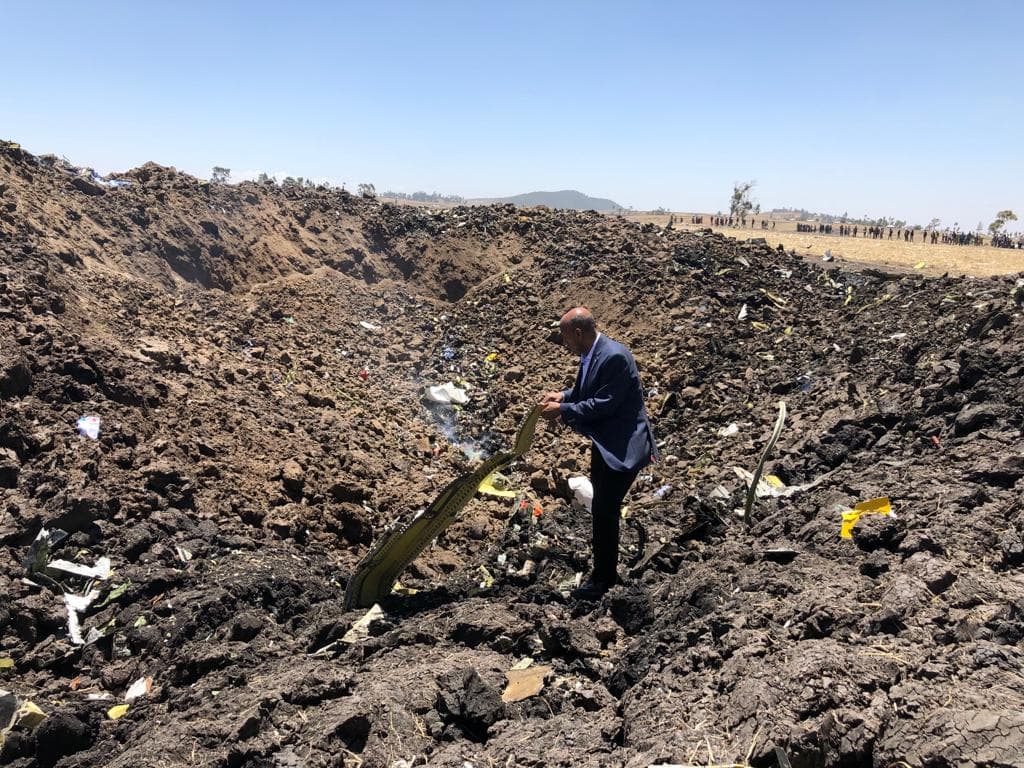
Ethiopian Airlines Group CEO Tewolde GebreMariam amid the wreckage of Flight ET 320. (Ethiopian Airlines)
157 people were killed Sunday morning when Ethiopian Airlines flight 302 crashed shortly after takeoff from the country’s capital city of Addis Ababa.
The Kenya-bound 737 MAX 8 was in flight for only six minutes before it lost contact with controllers and crashed near the town of Bishoftu, killing all on board. This is the second 737 MAX crash since Boeing delivered the first plane less than two years ago.
So far, the cause is unknown, but the airline announced Monday morning that it had recovered the digital flight data recorder and the cockpit voice recorder, considered invaluable tools when investigating an accident. Both were also eventually recovered in October’s Lion Air 737 MAX crash in Indonesia, which killed 189 people.
A final report on the Lion Air crash is not due out until later this year, but the preliminary report indicated that pilot difficulty with trim and inaccurate sensor information on the angle of attack played a role. Boeing subsequently released an update to its flight operations manual and detailed the process to control the plane if inaccurate sensor information lead the system to set a nose-down trim condition.
According to Ethiopian, the ET 302 underwent “a rigorous first check maintenance” on Feb. 4. The captain was Yared Getachew, who the carrier said had more than 8,000 flight hours.
ADS-B data gathered and shared by Flightradar24 shows that ET 302’s vertical speed was unstable after takeoff. Meteorological data shows that the area’s weather was good.
Ethiopian Airlines Group’s CEO, Tewolde GebreMariam, released a statement from the scene promising necessary support to the investigation and affected families but saying “it is too early to speculate the cause of the accident.”
“It is a brand new airplane with no technical remarks, flown by senior pilots, and there is no cause that we can see at this time,” he said in a press conference. The plane was delivered to Ethiopian less than six months ago.
“It is not possible to identify whether there was a landing [attempt],” GebreMariam said. “By the time we reached there, there was smoke.”
The Ethiopian Civil Aviation Authority (ECAA) is leading the investigation into the accident, but it has international help. The U.S. National Transportation Safety Board (NTSB) said it is sending four agents with expertise in systems/structures, powerplants and operations, and the FAA, Boeing and engine-maker The ECAA said it will enlist help from “all international stakeholders.”
That could be a lot, as there were passengers and crew from at least 35 countries on board, according to Ethiopian Airlines, including 8 Americans which were confirmed by the U.S. State Department.
As a company, Boeing released a statement expressing sympathies for the passengers on the flight and pledging to aid in the investigation under the direction of the NTSB. The company’s stock price plunged nearly 12 percent in the wake of the accident, which also dropped the Dow Jones Industrial Average, one-tenth of which is based on Boeing’s fortunes, by over 350 points. The planemaker has not said whether this latest crash will prompt any policy or technological adjustment with its 737 MAX line of aircraft.